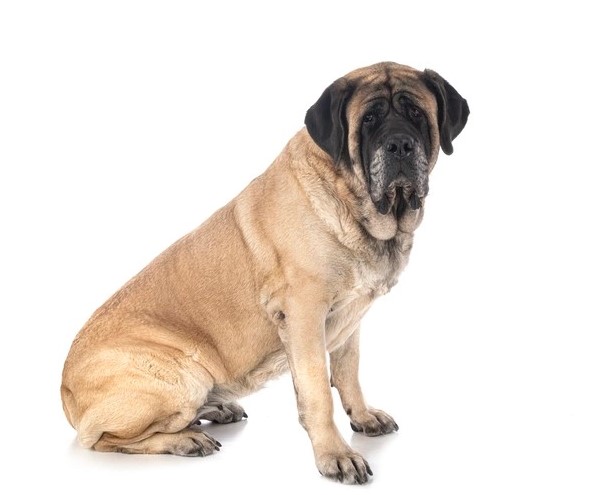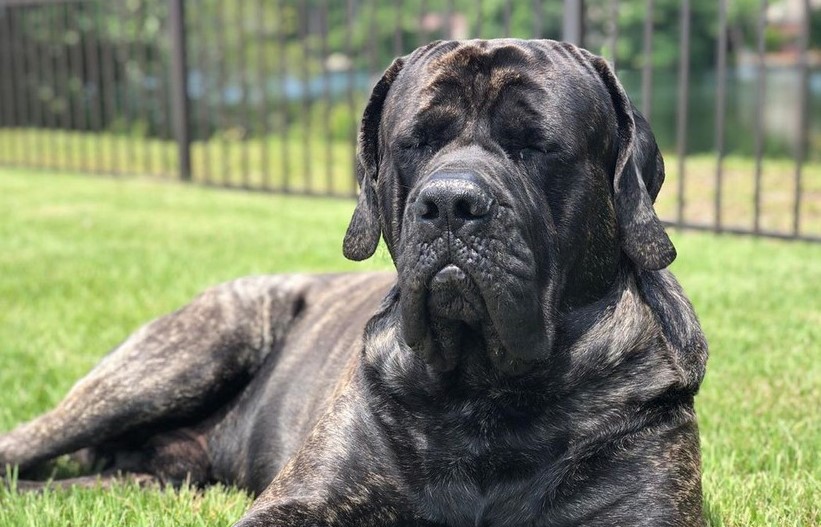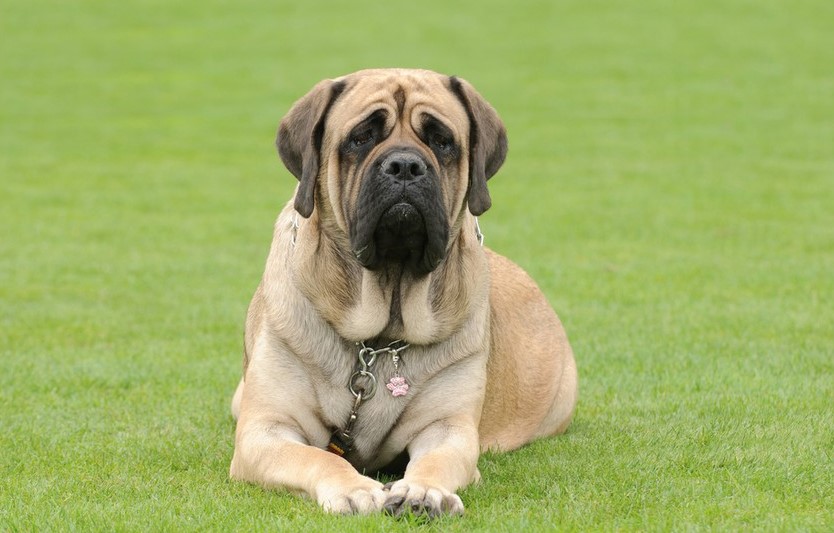
Mastiff is one of the oldest breeds. Her earliest ancestors, known as the Molossians, date back to 3000 BC. Today’s Mastiff is a family dog with a gentle and affectionate disposition. He is brave and incredibly strong, obedient but full of dignity.
Personality
A Mastiff is a patient companion, a reliable guardian and at the same time a formidable defender with an innate distrust of strangers. Owning such a powerful and huge dog imposes a lot of obligations on the owner, which should not be taken lightly.
In the modern world, Mastiffs are used as guard dogs and companions. Like many Molossians, they do not accept hierarchy in the group, but love and equally protect all family members. A quiet and calm Mastiff is ready at any time to turn into a formidable war machine, as soon as it considers that his family is in danger. However, this dog will never bite unnecessarily: it does not need it, as it is well aware of its strength.
The English Mastiff may not be the smartest dog in its class. Some owners of this breed say that their dog is more cute and funny than smart. This impression is formed due to the Mastiff’s immunity to certain external stimuli: for example, he may not react to extraneous sounds immediately, but only after some time. But this dog is very reliable and observant. If the Mastiff senses any threat, he will not hesitate to defend his masters.
Do not try to use the English Mastiff for hunting or in pursuit of prey: the predatory instinct in this dog is almost undeveloped.
The Mastiff is close to all members of his family: he never chooses one of them. Moreover, despite its great affection for the owners, the Mastiff knows how to maintain a distance when necessary. Although at the same time, despite its impressive size, this massive dog is a very sensitive creature that does not tolerate loneliness. He definitely needs the presence of a person in order to feel calm and comfortable.
As a puppy, the Mastiff is prone to destructive actions, especially if left alone for a long time. Out of boredom, he can begin to gnaw and chew the things of the owners. Therefore, if you are away for a long time during the day, try to walk with the puppy as much as possible before you leave so that he can spend excess energy.
Choosing this giant Mastiff as your first dog is quite risky. Although this breed has a rather pleasant character, the Mastiff is still a strong dog with a lot of stubbornness and willfulness. Gaps in upbringing can have disastrous consequences, but an experienced trainer “with an iron hand in a velvet glove” will become the ideal owner for a Mastiff.
In addition, the Mastiff should not be gotten by people of age: it is really a huge and powerful dog, which can be difficult to cope with even for very strong people.
Breed Standards
The English Mastiff is a huge dog that gives the impression of power, strength, and courage. She has a large head, massive muscles, a proportional body. The build is rough, but firm, somewhat raw. More mass comes from muscle, not fat. The format of the Mastiff is only slightly elongated: completely square, or very elongated dogs are unacceptable.
The large, square head doesn’t feel rough. Its width is one and a half times its length. All muscles adjacent to the skull are well developed. The forehead is somewhat convex, but by no means rounded. The brow ridges are noticeable, but not excessively, and somewhat stronger in males than in females. With a general dryness of the head, when the dog shows attention, deep folds appear on the forehead.
The transition from forehead to muzzle is neither too sharp, nor, conversely, smoothed. It is clearly visible, but nothing more. The muzzle line is parallel to the top of the skull. The muzzle is not long, by no means snub-nosed or drooping. It should not be too wide, much less narrow or sharp. Lips are unacceptable, as well as incomplete concealment of the teeth by the upper lip, its setting behind the lower jaw in front, or flabby flews. The nose is slightly flattened, with wide nostrils, pure black in color. The ears are set high, widely spaced. Hanging, not fleshy, not thick, of medium length, although due to the large head they seem short. They resemble a slightly rounded triangle in shape, lie close to the cheeks, and are directed forward.
Not too large eyes are traditionally brown, but a nutty shade is also acceptable. They look straight, set low, and not too deep. A mastiff can have both a straight and a scissor bite. In any case, the teeth should be healthy and free of plaque.
The neck next to the imposing head gives the impression of being short, while it is extremely athletic – not much narrower than the head. It is set neither too high nor too low, it has a slight bend. Two small folds of skin should be present at the throat, while their symmetry and length to about the middle of the neck are important. The withers are well-muscled, the shoulder blades are tightly pressed against the back. The back is broad, athletic, not long, but not short either. The loin is well muscled. The muscular and wide croup is slightly sloping towards the tail, but not too much.
The tail set high below the hock in length. Crescent-shaped, drooping down with a smooth bend. With concentration, the dog can rise to a horizontal state. Very well developed chest with well-developed muscles, extremely wide and deep. The abdomen is not too tucked up, but not lowered either. The forelegs are set wide apart and parallel. Dry, muscular. The elbows are not close to the body, but they are not too far apart. The pasterns are short. The hind legs are also heavily muscled, set wide apart and parallel. Paws are round and regular in shape.
The coat is double, the outer coat is hard, close to the body, short, without waviness. The undercoat is thick, shorter, and softer than the guard hair.
For any coat color the Mastiff’s ears, goggles, and face mask must be black.
It is not only the color that is important but also the symmetry of the above marks. The Mastiff itself can have an apricot-fawn, silver-fawn, or dark fawn-brindle color.
The minimum height is 75 cm and the weight is 70 kg.
Care
Keeping this massive dog is not as difficult as it sounds. The short coat of the Mastiff requires only a few regular brushings per week. And the dog’s love for such manipulations makes hair grooming sessions easy and enjoyable.
Molting in Mastiffs is usually moderate, intensifying only in spring and autumn.
The eyes and ears of the Mastiff must be carefully examined and cleaned with saline or a special agent. Avoid cotton pads or sticks for your ears, use sterile wipes instead. The nails should be trimmed at least once a month.
Health
This breed has been at risk of extinction several times but has always been revived thanks to the tremendous work of Mastiff connoisseurs. Usually, all work on the restoration of the breed was carried out using dogs that were consanguineous, which subsequently led to a certain genetic weakness of the breed.
The Mastiff has many health problems due to its enormous size. Frequent illnesses: orthopedic pathologies (due to rapid growth), hip and elbow dysplasia, cruciate ligament rupture, stomach torsion syndrome, osteosarcoma (bone cancer), multifocal retinopathy (eye disease), renal dysfunction, cardiomyopathy, volvulus, hyperthyroidism.
History of the Breed
Mastiffs trace their history back to ancient times. Images of dogs like them were found on bas-reliefs and figurines in Assyria in the 6th century BC.
In 55 BC, when Caesar’s legions invaded the British Isles, they had to face two types of dogs: the first was stocky, with a huge head in relation to the body and short but powerful jaws, as the calves could immediately verify. poor legionnaires. This dog, most likely, was the ancestor of the Bulldog and partly of the current Bullmastiff.
The second dog was of exceptional size and looked more like a lion than a dog. He was a direct descendant of the Assyrian-Babylonian Mastiffs, probably brought to England by the Phoenicians 500 years before the Roman invasion. Next to them, the Molossians from Epirus, whom the Romans considered very good war dogs, gave the impression of small sofa dogs. After the conquest of Britain, the Romans brought with them these impressive English dogs, which they called “British Scarecrows” and used them in the arenas against ferocious beasts and gladiators.
In The Canterbury Tales, the poet Jeffrey Chaucer calls them “Alerts” (the French name for the breed) and says they are “big as a bull.” The Mastiffs fought alongside the British against the French in 1415 at the Battle of Agincourt, later immortalized by Shakespeare.
After World War II, only 14 Mastiffs remained in all of England. The population of these dogs was restored with the help of American breeders, who exported the best representatives of the breed back to the metropolis. Today’s Mastiff is more obedient and friendly than its ancient ancestors, but no less daring.






